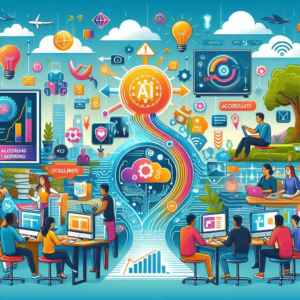
1. Introduction to Digital Skills in Manufacturing
In today’s rapidly evolving technological landscape, businesses must focus on accelerating digital skills to stay ahead of the competition. With the increasing reliance on automation, data analytics, and AI-driven decision-making, employees need to develop new competencies quickly. However, traditional training methods often take too long, creating skill gaps that slow down progress.
To tackle this challenge, organizations must implement strategies that reduce the time to competency while maintaining high-quality learning experiences. This blog explores practical steps to achieve these goals, ensuring a workforce that is skilled, adaptable, and ready for the digital future.
2. The Growing Need for Digital Skills in Manufacturing
The manufacturing industry has undergone a massive transformation due to digital technologies. Traditional job roles are evolving, and new opportunities are emerging, requiring employees to have skills in artificial intelligence (AI), data analytics, cybersecurity, and IoT.
To remain competitive, businesses must ensure that employees not only gain technical expertise but also develop the ability to adapt to rapid change. By focusing on continuous learning, organizations can bridge the gap between current skill levels and future demands.
Moreover, reducing the time to competency ensures that new hires and existing employees quickly become productive. The faster employees master essential digital skills, the greater the impact on business growth and innovation.
3. Key Strategies for Developing Digital Skills
Organizations can accelerate digital skill development and shorten the time to competency by implementing these key strategies:
3.1 Define Clear Objectives and Outcomes
Setting well-defined learning objectives helps organizations focus on the most critical digital skills. Companies should:
– Identify the core skills required for digital transformation.
– Align training programs with business goals and industry needs.
– Set measurable learning outcomes to track progress effectively.
By defining clear objectives, companies ensure that training efforts remain structured and effective.
3.2 Conduct a Skills Gap Analysis
Before launching any training programs, businesses must assess their current workforce capabilities. Conducting a skills gap analysis helps organizations:
– Identify key areas for improvement.
– Customize training programs based on specific needs.
– Prioritize skills that offer maximum business impact.
A thorough analysis ensures that training efforts are targeted and efficient.
3.3 Leverage Technology for Learning
Modern learning tools make it easier for employees to acquire digital skills quickly. Organizations should:
– Use AI-driven learning platforms to personalize training.
– Implement virtual classrooms for flexible learning.
– Offer mobile-friendly training solutions for remote access.
By incorporating digital learning tools, businesses can create a more engaging and effective learning environment.
3.4 Implement a Blended Learning Approach
A combination of online courses, hands-on workshops, and instructor-led sessions provides a balanced learning experience. Blended learning:
– Enables employees to learn at their own pace.
– Incorporates real-world applications for practical understanding.
– Enhances knowledge retention through interactive experiences.
This method ensures that training is both efficient and impactful.
3.5 Foster a Culture of Continuous Learning
Encouraging employees to learn continuously is essential for long-term success. Companies should:
– Provide access to online certifications and professional courses.
– Establish mentorship programs for peer-to-peer learning.
– Recognize and reward employees who actively upskill.
A culture of learning ensures that employees remain adaptable and innovative.
3.6 Utilize Microlearning Techniques
Microlearning involves short, focused lessons that employees can complete quickly. This method:
– Helps workers absorb key concepts faster.
– Fits seamlessly into busy schedules.
– Allows employees to apply new skills immediately.
By breaking down learning into smaller modules, businesses can speed up competency development.
3.7 Monitor and Evaluate Training Progress
Measuring the effectiveness of training helps businesses refine their strategies. Organizations should:
– Set key performance indicators (KPIs) to track learning outcomes.
– Gather feedback from employees to improve training materials.
– Adjust learning methods based on real-time performance data.
Regular evaluation ensures that training programs remain relevant and effective.
3.8 Promote Knowledge Sharing and Collaboration
Creating a collaborative work environment helps employees learn from one another. Companies can:
– Develop internal forums for skill-sharing.
– Encourage cross-functional teamwork.
– Organize hackathons and innovation challenges to foster creativity.
Knowledge-sharing accelerates learning and enhances team productivity.
3.9 Invest in Leadership Development
Leaders play a crucial role in driving digital transformation. Companies should:
– Train managers on digital leadership skills.
– Equip leaders with change management expertise.
– Encourage executives to champion continuous learning.
Strong leadership ensures that digital skills development remains a top priority.
3.10 Align Training with Business Goals
For digital skills training to be successful, it must align with business objectives. Companies should:
– Link training outcomes to organizational performance.
– Integrate digital skills development into long-term strategy.
– Ensure that learning programs contribute to overall business growth.
A well-aligned strategy maximizes the return on investment in employee development.
Conclusion
Accelerating digital skills development is essential for organizations looking to thrive in today’s fast-paced digital economy. By implementing strategies such as blended learning, AI-driven training, microlearning, and leadership development, companies can significantly reduce the time to competency.
Additionally, fostering a culture of continuous learning and collaboration ensures that employees remain agile and innovative. When organizations align training initiatives with business goals, they create a sustainable path for long-term success.
Moreover, the transformative power of DevOps in modern software development has shown how skill-driven approaches lead to improved efficiency, automation, and faster deployments. Similarly, in manufacturing, prioritizing digital skill enhancement can unlock greater productivity and operational excellence.
At Cloudastra Technologies, we specialize in workforce transformation solutions that empower businesses to adapt, innovate, and excel. Visit us to discover how we can help you navigate the future of digital manufacturing.
Do you like to read more educational content? Read our blogs at Cloudastra Technologies or contact us for business enquiry at Cloudastra Contact Us.